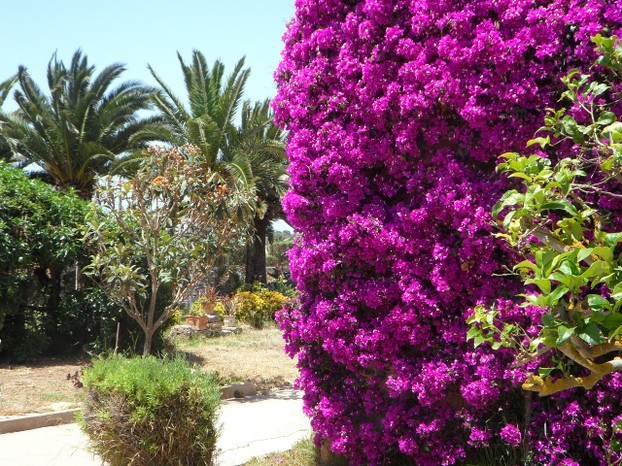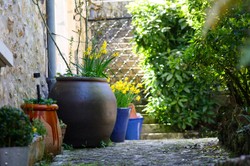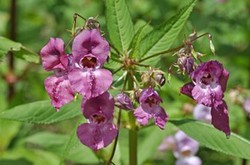The world is growing warmer, ice caps are melting and weather patterns changing, and this alteration in in climate is influencing the way in which we farm and garden. Put simply, the warmer zones are moving northwards. This means that areas which once might have been unsuitable for certain types of crops now become suitable, but at the other end some areas are becoming too hot for the crops that have traditionally been grown there. This seems to be the case in parts of Europe, as the Mediterranean countries, already hot in summer, are becoming intolerably hot and dry at times. Furthermore, the conditions can be variable, for sometimes these climates can be tolerable, but then can come a heat wave that takes temperatures soaring to over a hundred degrees for a sustained period of time.Not only do crops suffer, but gardeners too can wilt under the ferocity of a heatwave, leaving jobs undone.
With excessive heat comes drought, which challenges farmers and gardeners, who need to find water for their crops, but along with drought there comes the danger of fire. In some areas, such as California, we see whole swathes of land destroyed by fire, but even in Britain, where such bush fires are not a phenomenon, we can have moorland fires, when dry peat starts to burn and inflames the dry heather. These have never threatened a town, but they can take a significant time to quell, as the fire continues underground, leaving the fire fighters longing for rain.
But weather patterns also change with the climate. Britain is a rainy place and we have had rarely had serious droughts, and on the whole we have had few extreme weather events. The British climate contains a measure of unpredictability, it always has, But in recent years gardeners and farmers have been at a loss to know what weather is coming in Spring and summer, as it has been so unpredictable. Springtime seems to have been drier recently. Two years ago it was very chilly, but last year not so bad.
But what is happening is that some predictions seem to be coming true. Britain is divided by an imaginary line, the Tees-Exe line. To trace this take a map and find the mouth of the river Exe in the South West. Find the mouth of the Tees in North East England and draw a slightly curved line that just touches the southern tip of the Pennine range, and this is the Tees-Exe line. North West of it is mainly highland Britain, though there are some large lowland areas, such as where I live; but South East is lowland Britain, with just some small hills. North and West of the line we have been predicted to have stormier winters, but South and East drier summers, even to drought conditions at times. This is already happening. Gardeners need to take into account the type of changes that are affecting their area.










 TheThousand Year Gardenon 11/26/2025
TheThousand Year Gardenon 11/26/2025
 Women of the Gospelson 10/11/2025
Women of the Gospelson 10/11/2025
 Religious Gardenson 08/25/2025
Religious Gardenson 08/25/2025
 Doctor of the Church: John Henry Newmanon 08/03/2025
Doctor of the Church: John Henry Newmanon 08/03/2025



Comments
Yes, but they are now frowned on and some users have ceased to use them to save water.
Thank you for your comment below, on Dec. 20, 2023, in answer to my previous, previous-day observation and question Dec. 19, 2023.
Do British-Isles-ers and British-Isles businesses on their respective lawns do sprinkler spraying?
This seems to be more of an American practice than a British one.
The second paragraph to the second subheading, Mulch and water, alerts us that "Outside I direct the water to the plants' roots, so that none is wasted, and the idea of spraying water around in a sprinkler is not to my liking."
Running through or standing amid sprinkler-sprayed water delighted me -- who learned swimming concomitantly with walking -- in the earliest elementary-school days.
But me too, my gardening practices do not delight in sprinklered irrigation.
Unitedstatesian businesses engage in night-lighted buildings and in sprinklered irrigation. Might the two practices commonly be seen on your eastern pond side?
Some have survived, those with Tudor topiary.
The very first sentence advises that famous and traditional gardens may go back to the Tudor period.
Have no famous, traditional gardens survived from pre-Tudor times?
I found a lot of interesting information here. A really good post, very thankful and hopeful that you will write many more posts like this one.
Climate change, and possibly El Nino, are behind the storms which still beset us in northern Britain, and my area has been hit, though I personally am not a victim and the nearest floods were a mile or so from my house. Even then they were only shallow. But in parts of the country gardeners will have to deal with the problem of waterlogged soil. Some of us will have to learn to repair flooded soil. We must learn drainage techniques, if we dwell in flood prone areas. Raised beds may be essential for some gardeners in such locations.
I have the Mediterranean garden with too much lawn. One member of the household is a hard hard for the green lawn. We are slowly whittling it away, though.
Great informative article! I live in the US but global warming is real and I learned a lot.